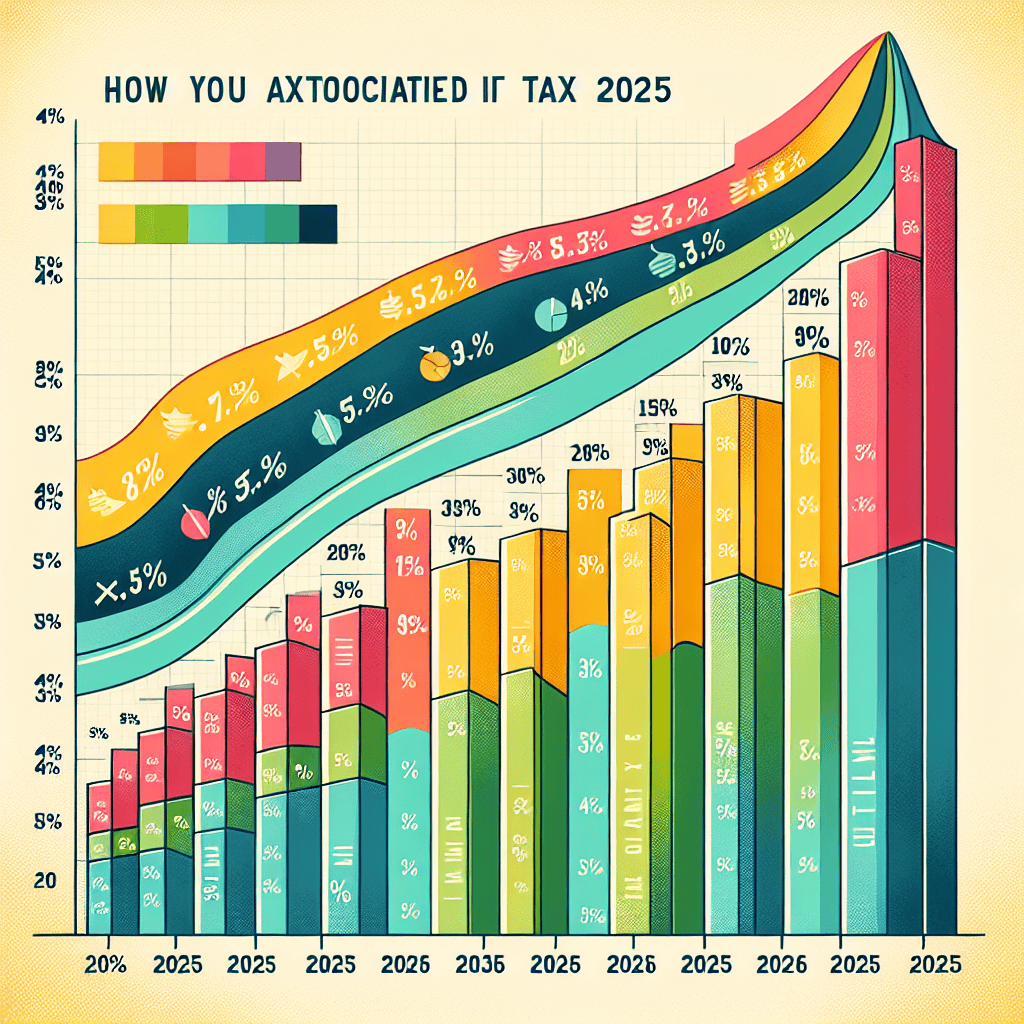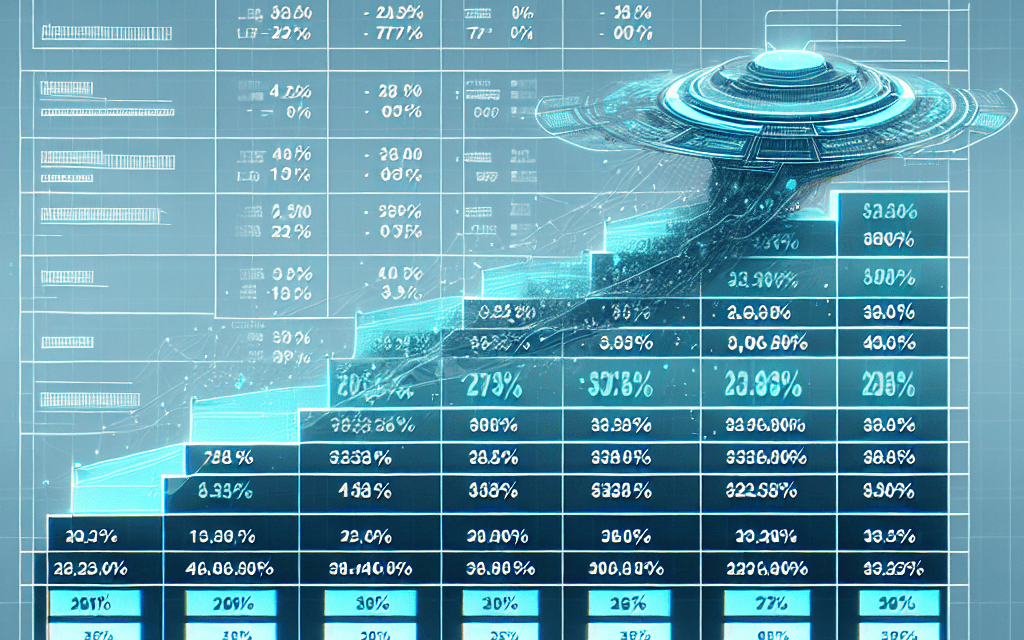“Navigate Your Future Finances: Unveiling the 2025 Tax Brackets”
Introduction
In the ever-evolving landscape of personal finance, understanding the intricacies of tax brackets is crucial for effective financial planning. As we approach 2025, taxpayers are keen to uncover what the future holds for their tax obligations. The 2025 tax brackets, shaped by economic shifts and legislative changes, will play a pivotal role in determining how much individuals and families owe to the government. This guide delves into the anticipated tax brackets for 2025, offering insights into potential adjustments and their implications on your financial strategy. By exploring these projections, you can better prepare for the upcoming tax season, ensuring that you optimize your financial decisions and minimize your tax liabilities.
Understanding the 2025 Tax Brackets: Key Changes and Implications
As we approach the year 2025, taxpayers are keenly interested in understanding the changes to the tax brackets and what these adjustments mean for their financial planning. The tax brackets for 2025 have been adjusted to reflect inflation and other economic factors, which can significantly impact the amount individuals and families owe to the federal government. It is crucial for taxpayers to familiarize themselves with these changes to effectively manage their finances and optimize their tax liabilities.
To begin with, the tax brackets for 2025 have been modified to accommodate inflationary pressures, a common practice aimed at preventing “bracket creep,” where taxpayers are pushed into higher tax brackets due to inflation rather than an actual increase in real income. This adjustment ensures that taxpayers are not unfairly penalized by inflationary increases in their nominal income. Consequently, the income thresholds for each tax bracket have been raised, allowing taxpayers to retain more of their income before moving into a higher tax bracket.
Moreover, the 2025 tax brackets continue to reflect the progressive nature of the U.S. tax system, where higher income levels are taxed at higher rates. This system is designed to ensure that those with greater financial resources contribute a fair share to the nation’s revenue. The tax rates themselves have remained consistent with previous years, maintaining the seven-bracket structure that ranges from 10% for the lowest income earners to 37% for the highest. However, the income thresholds for these brackets have been adjusted, which may result in some taxpayers experiencing a shift in their applicable tax rate.
In addition to the changes in income thresholds, taxpayers should also be aware of potential modifications to deductions and credits that can influence their overall tax liability. For instance, the standard deduction, a critical component for many taxpayers, has been adjusted for inflation, providing a slight increase in the amount that can be deducted from taxable income. This adjustment can be particularly beneficial for those who do not itemize deductions, as it reduces the amount of income subject to taxation.
Furthermore, it is important to consider the implications of these tax bracket changes on various aspects of financial planning. For instance, individuals may need to reassess their withholding allowances to ensure they are not overpaying or underpaying taxes throughout the year. Additionally, those engaged in retirement planning should evaluate how these changes might affect their contributions to tax-advantaged accounts, such as 401(k)s and IRAs, to maximize their tax benefits.
In conclusion, understanding the 2025 tax brackets and their implications is essential for effective financial planning. By staying informed about these changes, taxpayers can make strategic decisions to minimize their tax liabilities and optimize their financial well-being. As the tax landscape continues to evolve, it is advisable for individuals to consult with tax professionals or utilize reliable resources to ensure they are fully aware of how these changes impact their specific financial situations. By doing so, taxpayers can navigate the complexities of the tax system with confidence and make informed decisions that align with their financial goals.
How the 2025 Tax Brackets Affect Different Income Levels
As we approach 2025, understanding the upcoming tax brackets becomes crucial for individuals and families planning their financial futures. The tax brackets for 2025 are set to reflect adjustments for inflation, as well as potential legislative changes that may impact taxpayers across various income levels. By examining how these brackets affect different income groups, individuals can better prepare for their financial obligations and make informed decisions about their finances.
To begin with, it is essential to recognize that tax brackets are designed to impose a progressive tax system, where individuals with higher incomes pay a larger percentage of their earnings in taxes. This system aims to ensure a fair distribution of the tax burden across different income levels. In 2025, the tax brackets are expected to maintain this progressive structure, with adjustments to account for inflation. Consequently, taxpayers may find themselves in different brackets compared to previous years, even if their real income has not changed significantly.
For low-income earners, the 2025 tax brackets may offer some relief. These individuals typically fall into the lowest tax brackets, which are subject to the smallest percentage of taxation. With inflation adjustments, the income thresholds for these brackets may increase, allowing more individuals to qualify for lower tax rates. This change can result in reduced tax liabilities for low-income earners, providing them with more disposable income to meet their basic needs and improve their quality of life.
Moving up the income scale, middle-income earners may experience varying effects from the 2025 tax brackets. While inflation adjustments can also benefit this group by raising the income thresholds for their respective brackets, other factors such as changes in tax credits and deductions may influence their overall tax burden. For instance, if certain deductions are reduced or eliminated, middle-income taxpayers might face higher effective tax rates despite the bracket adjustments. Therefore, it is crucial for individuals in this income range to stay informed about potential legislative changes that could impact their tax liabilities.
High-income earners, on the other hand, are likely to see the most significant impact from the 2025 tax brackets. As they fall into the highest tax brackets, any changes in tax rates or thresholds can substantially affect their financial obligations. Moreover, policymakers often target high-income individuals for additional tax revenue, which could result in increased rates or the introduction of new taxes. Consequently, high-income earners should closely monitor any proposed tax reforms and consider strategies such as tax-efficient investments or charitable contributions to mitigate their tax liabilities.
In addition to income levels, other factors such as filing status and family size can also influence how the 2025 tax brackets affect taxpayers. For example, married couples filing jointly may benefit from wider income thresholds compared to single filers, potentially reducing their overall tax burden. Similarly, families with dependents might qualify for additional tax credits, further alleviating their financial responsibilities.
In conclusion, the 2025 tax brackets will have varying effects on different income levels, with low-income earners potentially benefiting from inflation adjustments, middle-income earners facing a mix of influences, and high-income earners experiencing significant impacts. By understanding these dynamics and staying informed about potential legislative changes, taxpayers can better navigate the evolving tax landscape and make informed decisions to optimize their financial well-being.
Strategies to Minimize Your Tax Liability in 2025
As we approach the year 2025, understanding the evolving tax landscape becomes increasingly crucial for individuals and businesses alike. The new tax brackets set to take effect in 2025 will undoubtedly influence financial planning and decision-making. Therefore, it is essential to explore strategies that can help minimize your tax liability in this changing environment. By proactively addressing these changes, taxpayers can better position themselves to optimize their financial outcomes.
One of the most effective strategies to reduce tax liability is to maximize contributions to retirement accounts. In 2025, the contribution limits for traditional and Roth IRAs, as well as 401(k) plans, are expected to increase, allowing taxpayers to defer more income and potentially lower their taxable income. By taking full advantage of these increased limits, individuals can not only reduce their current tax burden but also enhance their long-term financial security. Additionally, contributing to a Health Savings Account (HSA) can provide a dual benefit of reducing taxable income while saving for future medical expenses.
Another key strategy involves leveraging tax credits, which directly reduce the amount of tax owed. In 2025, several credits may be available, including those for energy-efficient home improvements and electric vehicle purchases. By investing in energy-efficient technologies or opting for environmentally friendly transportation, taxpayers can not only contribute to a sustainable future but also enjoy significant tax savings. Furthermore, education-related credits, such as the Lifetime Learning Credit, can provide relief for those pursuing further education or skill development.
Taxpayers should also consider the timing of income and deductions as a means to manage their tax liability. For instance, deferring income to a subsequent year or accelerating deductions into the current year can be advantageous, depending on one’s financial situation and the anticipated tax bracket changes. This approach requires careful planning and a thorough understanding of the tax code, but it can yield substantial benefits when executed correctly.
Moreover, charitable contributions remain a valuable tool for reducing taxable income. In 2025, taxpayers can continue to benefit from donating to qualified charitable organizations. By itemizing deductions and strategically planning charitable giving, individuals can support causes they care about while simultaneously lowering their tax obligations. It is important to keep detailed records of all contributions to ensure compliance with IRS requirements and to maximize the potential tax benefits.
For business owners, taking advantage of available deductions and credits is essential. The 2025 tax code may offer opportunities for deductions related to business expenses, research and development, and employee benefits. By staying informed about these provisions and maintaining meticulous records, businesses can effectively reduce their taxable income and enhance their financial position.
In conclusion, as the 2025 tax brackets come into effect, taxpayers must adopt a proactive approach to minimize their tax liability. By maximizing retirement contributions, leveraging tax credits, strategically timing income and deductions, making charitable contributions, and utilizing business-related deductions, individuals and businesses can navigate the new tax landscape with confidence. It is advisable to consult with a tax professional to tailor these strategies to your specific circumstances and ensure compliance with the latest regulations. By doing so, you can optimize your financial outcomes and achieve greater peace of mind in the face of changing tax obligations.
Comparing 2025 Tax Brackets with Previous Years: What’s New?

As we approach the year 2025, taxpayers are keenly interested in understanding how the new tax brackets will affect their financial obligations. The tax landscape is ever-evolving, and with each passing year, adjustments are made to accommodate economic shifts, inflation, and policy changes. The 2025 tax brackets introduce several modifications that distinguish them from previous years, and it is crucial for taxpayers to comprehend these changes to effectively plan their finances.
To begin with, one of the most notable changes in the 2025 tax brackets is the adjustment for inflation. This adjustment is a routine measure that aims to prevent “bracket creep,” where taxpayers are pushed into higher tax brackets due to inflation rather than an actual increase in real income. The Internal Revenue Service (IRS) uses the Chained Consumer Price Index (C-CPI) to make these adjustments, ensuring that the tax system remains fair and equitable. Consequently, the income thresholds for each tax bracket have been slightly increased, providing some relief to taxpayers who might otherwise face higher tax rates due to inflationary pressures.
In addition to inflation adjustments, the 2025 tax brackets reflect policy changes that have been implemented to address economic disparities and promote fiscal responsibility. For instance, there is a slight increase in the top marginal tax rate, which is aimed at ensuring that high-income earners contribute a fair share to the nation’s revenue. This change is part of a broader effort to address income inequality and generate additional funds for public services and infrastructure projects. While this may result in a higher tax burden for the wealthiest individuals, it is expected to have a minimal impact on middle and lower-income taxpayers.
Moreover, the 2025 tax brackets introduce new provisions for families and individuals, particularly in the form of expanded tax credits. The Child Tax Credit, for example, has been enhanced to provide greater financial support to families with children. This change is designed to alleviate the financial strain on families and encourage economic stability. Similarly, the Earned Income Tax Credit has been adjusted to benefit a broader range of low to moderate-income workers, thereby incentivizing employment and reducing poverty levels.
Another significant aspect of the 2025 tax brackets is the emphasis on simplifying the tax filing process. The IRS has made efforts to streamline tax forms and reduce the complexity of tax calculations, making it easier for taxpayers to understand their obligations and file their returns accurately. This simplification is expected to reduce errors and improve compliance, ultimately benefiting both taxpayers and the government.
In comparing the 2025 tax brackets with those of previous years, it is evident that the changes are designed to address contemporary economic challenges while maintaining a fair and balanced tax system. The adjustments for inflation, policy-driven rate changes, and enhanced tax credits collectively aim to create a more equitable tax environment. As taxpayers navigate these changes, it is advisable to stay informed and seek professional advice if necessary to ensure compliance and optimize their tax situation. By understanding the nuances of the 2025 tax brackets, individuals and families can better prepare for their financial future and make informed decisions that align with their economic goals.
The Impact of 2025 Tax Brackets on Small Business Owners
As we approach 2025, small business owners are keenly observing the evolving tax landscape, particularly the anticipated changes in tax brackets. Understanding these changes is crucial for strategic financial planning and ensuring compliance with federal tax obligations. The 2025 tax brackets are expected to reflect adjustments that could significantly impact small business owners, influencing their financial decisions and overall business strategy.
To begin with, the tax brackets for 2025 are projected to incorporate inflation adjustments, a routine practice aimed at preventing “bracket creep,” where inflation pushes income into higher tax brackets, thereby increasing tax liability without an actual increase in real income. For small business owners, this means that while their nominal income might rise, the inflation-adjusted brackets could mitigate the impact on their tax obligations. However, it is essential to note that these adjustments might not fully offset the effects of inflation, necessitating careful financial planning.
Moreover, the potential changes in tax rates themselves are a focal point for small business owners. Any increase in tax rates could lead to higher tax liabilities, affecting cash flow and profitability. Conversely, a decrease in rates might provide some relief, allowing business owners to reinvest savings into their operations. Therefore, staying informed about legislative developments and proposed tax reforms is vital for small business owners to anticipate and adapt to these changes.
In addition to the tax brackets, small business owners must also consider the implications of deductions and credits, which can significantly influence their effective tax rate. The 2025 tax landscape may introduce new deductions or modify existing ones, impacting how businesses calculate their taxable income. For instance, changes in the standard deduction or business expense deductions could alter the overall tax burden. Small business owners should work closely with tax professionals to identify opportunities for maximizing deductions and credits, thereby optimizing their tax position.
Furthermore, the structure of the business entity plays a crucial role in determining tax liability. Whether operating as a sole proprietorship, partnership, S corporation, or C corporation, each entity type is subject to different tax rules and rates. The 2025 tax brackets may affect these entities differently, necessitating a thorough evaluation of the most tax-efficient structure for a given business. Small business owners might consider restructuring their business to take advantage of more favorable tax treatment, depending on the anticipated changes.
Additionally, the impact of state and local taxes cannot be overlooked. While federal tax brackets are a primary concern, state and local tax obligations also contribute to the overall tax burden. Small business owners should be aware of any changes at these levels that might coincide with federal adjustments, as they collectively influence the financial health of a business.
In conclusion, the 2025 tax brackets present both challenges and opportunities for small business owners. By staying informed and proactive, they can navigate these changes effectively, ensuring compliance while optimizing their tax position. Engaging with tax professionals and financial advisors will be crucial in developing strategies that align with the evolving tax landscape. As the year 2025 approaches, small business owners must remain vigilant, adapting their financial strategies to accommodate the anticipated changes in tax brackets and related regulations.
Navigating Deductions and Credits Under the 2025 Tax Brackets
As taxpayers prepare for the 2025 tax season, understanding the nuances of deductions and credits becomes increasingly important. The 2025 tax brackets have been adjusted to reflect changes in the economy, and these adjustments can significantly impact the amount owed by individuals and families. To navigate these changes effectively, it is essential to comprehend how deductions and credits can be utilized to minimize tax liabilities.
Deductions play a crucial role in reducing taxable income, thereby potentially lowering the overall tax burden. In 2025, standard deductions have been slightly increased to account for inflation, providing taxpayers with a modest relief. For single filers, the standard deduction has risen to $13,850, while married couples filing jointly can now claim a deduction of $27,700. These adjustments aim to simplify the filing process for many taxpayers, allowing them to reduce their taxable income without itemizing deductions.
However, for those who choose to itemize, understanding the available deductions is vital. Mortgage interest, state and local taxes, and charitable contributions remain key components of itemized deductions. It is important to note that the cap on state and local tax deductions remains at $10,000, a limit that has been in place since the Tax Cuts and Jobs Act of 2017. Taxpayers should carefully evaluate whether itemizing provides a greater benefit than the standard deduction, as this decision can significantly influence their tax liability.
In addition to deductions, tax credits offer another avenue for reducing the amount owed. Unlike deductions, which lower taxable income, credits directly reduce the tax bill. The 2025 tax brackets continue to support several valuable credits, including the Child Tax Credit and the Earned Income Tax Credit. The Child Tax Credit remains at $2,000 per qualifying child, with up to $1,500 being refundable, providing substantial relief for families. Meanwhile, the Earned Income Tax Credit continues to support low- to moderate-income workers, with the maximum credit for a family with three or more children reaching $7,000.
Moreover, education-related credits such as the American Opportunity Credit and the Lifetime Learning Credit remain available, offering financial relief to those pursuing higher education. The American Opportunity Credit provides up to $2,500 per eligible student, while the Lifetime Learning Credit offers up to $2,000 per tax return. These credits can significantly offset the costs of tuition and related expenses, making education more accessible.
As taxpayers navigate the 2025 tax brackets, it is crucial to remain informed about any legislative changes that may affect deductions and credits. Staying updated on tax laws and consulting with a tax professional can provide valuable insights and ensure compliance with current regulations. Additionally, utilizing tax software or online resources can simplify the filing process, helping taxpayers identify potential deductions and credits they may qualify for.
In conclusion, understanding the interplay between deductions and credits is essential for effectively navigating the 2025 tax brackets. By strategically utilizing these tools, taxpayers can minimize their tax liabilities and potentially increase their refunds. As the tax landscape continues to evolve, staying informed and proactive will be key to successfully managing one’s financial obligations.
Preparing for the 2025 Tax Season: Essential Tips and Tools
As the 2025 tax season approaches, understanding the new tax brackets and preparing accordingly is crucial for taxpayers aiming to optimize their financial strategies. The Internal Revenue Service (IRS) periodically adjusts tax brackets to account for inflation and other economic factors, and 2025 is no exception. These adjustments can significantly impact how much individuals and families owe, making it essential to stay informed and plan ahead.
To begin with, the 2025 tax brackets have been adjusted to reflect changes in the cost of living, which can affect taxpayers across various income levels. For instance, the income thresholds for each bracket have been slightly increased, which may result in some taxpayers falling into a lower bracket than in previous years. This shift can potentially reduce the overall tax burden for many, but it also necessitates a careful review of one’s financial situation to ensure accurate tax planning.
In addition to understanding the new brackets, taxpayers should also consider the implications of other tax-related changes that may come into effect in 2025. For example, adjustments to standard deductions, personal exemptions, and tax credits can all influence the final tax liability. Staying informed about these changes is vital, as they can offer opportunities for tax savings or require adjustments to withholding and estimated tax payments.
Moreover, utilizing tax preparation tools and resources can greatly assist in navigating the complexities of the 2025 tax season. Many taxpayers find value in using tax software, which can simplify the filing process by automatically calculating tax liabilities based on the latest regulations. These tools often include features that help identify potential deductions and credits, ensuring that taxpayers do not overlook any opportunities to reduce their tax bill.
Furthermore, consulting with a tax professional can provide personalized guidance tailored to individual circumstances. Tax professionals are well-versed in the latest tax laws and can offer strategic advice on how to minimize tax liabilities while remaining compliant with all regulations. This can be particularly beneficial for those with complex financial situations, such as business owners or individuals with multiple income streams.
As taxpayers prepare for the 2025 tax season, it is also important to keep meticulous records of all financial transactions throughout the year. This includes maintaining documentation for income, expenses, and any potential deductions or credits. Organized records not only facilitate a smoother filing process but also serve as essential evidence in the event of an audit.
In conclusion, preparing for the 2025 tax season involves a comprehensive understanding of the new tax brackets and related changes, as well as utilizing available tools and professional advice. By staying informed and proactive, taxpayers can effectively manage their tax obligations and potentially reduce their overall tax burden. As the tax landscape continues to evolve, maintaining a strategic approach to tax planning will remain a key component of financial well-being.
Q&A
1. **What are the 2025 federal income tax brackets?**
The 2025 federal income tax brackets are not yet officially determined, as they are subject to legislative changes and inflation adjustments.
2. **How are tax brackets adjusted for inflation?**
Tax brackets are adjusted annually based on the Consumer Price Index (CPI) to account for inflation, ensuring that taxpayers are not pushed into higher brackets solely due to inflation.
3. **Will the Tax Cuts and Jobs Act (TCJA) affect the 2025 tax brackets?**
The TCJA provisions are set to expire at the end of 2025, which could result in a reversion to pre-2018 tax rates and brackets unless new legislation is enacted.
4. **What is the standard deduction for 2025?**
The standard deduction for 2025 will be adjusted for inflation, but specific amounts will be determined closer to the year.
5. **How might tax rates change in 2025?**
Tax rates in 2025 could change if Congress enacts new tax legislation or if the TCJA provisions expire, potentially increasing rates.
6. **What impact will the expiration of TCJA have on taxpayers?**
If the TCJA expires, taxpayers may face higher tax rates and lower standard deductions, leading to increased tax liabilities.
7. **How can taxpayers prepare for potential changes in 2025 tax brackets?**
Taxpayers can prepare by staying informed about legislative developments, consulting with tax professionals, and considering tax planning strategies to mitigate potential increases.
Conclusion
The 2025 tax brackets will determine the amount of federal income tax individuals owe based on their taxable income and filing status. These brackets are subject to change due to inflation adjustments and potential legislative updates. Understanding the 2025 tax brackets is crucial for effective financial planning, as it allows taxpayers to estimate their tax liabilities, optimize deductions, and make informed decisions about investments and retirement contributions. By staying informed about these changes, individuals can better manage their finances and potentially reduce their overall tax burden.





